This is the second of two columns featuring books by authors who are participating in Author Meetups, part of Children’s Literature Day at the ILA 2018 Conference, July 20–23 in Austin, TX. This column includes reviews of books in various genres and four age groups (Early Reader, Middle Grade, Early Young Adult, and Older Young Adult) that are inspiring, informative, and engaging.
Early Reader (Ages 4–8)
Drawn Together. Minh Lê. Ill. Dan Santat. 2018. Disney-Hyperion.
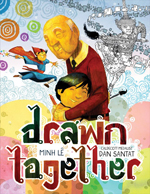 When a young boy visits his grandfather, they share lunch (although they eat different foods) and television (although the boy would like to watch something else) but cannot share language. When the boy finally pulls out his sketch book and markers to draw, his grandfather pulls out his brush and ink to draw with him. The lavish illustrations, done in both black-and-white and full-color mixed media, show how the pair create marvelous worlds of skilled warriors and fabulous stories, using the common language of art to bridge the traditional and the modern.
When a young boy visits his grandfather, they share lunch (although they eat different foods) and television (although the boy would like to watch something else) but cannot share language. When the boy finally pulls out his sketch book and markers to draw, his grandfather pulls out his brush and ink to draw with him. The lavish illustrations, done in both black-and-white and full-color mixed media, show how the pair create marvelous worlds of skilled warriors and fabulous stories, using the common language of art to bridge the traditional and the modern.
—SW
How Sweet the Sound: The Story of Amazing Grace. Carole Boston Weatherford. Ill. Frank Morrison. 2018. Atheneum/Simon & Schuster.
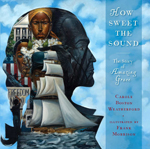 Weatherford’s rhyming couplets and Morrison’s dramatic double-spread oil paintings describe how British seaman John Newton (1725–1807) prays to God to spare his life one stormy night in 1748 aboard the Greyhound slave ship. After retiring from life at sea, he becomes a minister and anti-slavery activist and, during that time, writes the hymn “Amazing Grace." The story then shifts to the history of the hymn as other verses are added and different groups make the song their own. Back matter includes the lyrics, an author’s note, and suggestions for reading and listening.
Weatherford’s rhyming couplets and Morrison’s dramatic double-spread oil paintings describe how British seaman John Newton (1725–1807) prays to God to spare his life one stormy night in 1748 aboard the Greyhound slave ship. After retiring from life at sea, he becomes a minister and anti-slavery activist and, during that time, writes the hymn “Amazing Grace." The story then shifts to the history of the hymn as other verses are added and different groups make the song their own. Back matter includes the lyrics, an author’s note, and suggestions for reading and listening.
—CA
Sparkle Boy. Lesléa Newman. Ill. Maria Mola. 2017. Lee & Low.
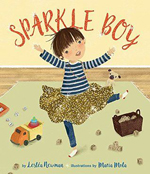 Casey loves all things glittery and sparkly, so when he sees his sister, Jessie, wearing a shimmery skirt, nail polish, and bangles, he wants them too. The illustrations, created in pencil and computer-generated color, depict his supportive parents and Abuelita. When Casey is teased by his classmates, who insist that “Boys don’t wear skirts and bracelets and nail polish," Jessie decides to celebrate her creative younger brother.
Casey loves all things glittery and sparkly, so when he sees his sister, Jessie, wearing a shimmery skirt, nail polish, and bangles, he wants them too. The illustrations, created in pencil and computer-generated color, depict his supportive parents and Abuelita. When Casey is teased by his classmates, who insist that “Boys don’t wear skirts and bracelets and nail polish," Jessie decides to celebrate her creative younger brother.
—SW
Middle Grade (Ages 8–12)
Judy Moody and the Right Royal Tea Party. Megan McDonald. Ill. Peter H. Reynolds. 2018. Candlewick.
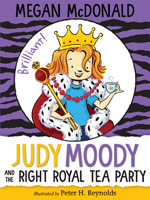 Judy Moody is in a “royal purple on-top-of-spaghetti-and-the-London-Eye mood!” Grandma Lou, who is helping Judy with her family tree project, has shown her some records that trace the Moody family back to the time of Queen Elizabeth I and tell a story about Cousin Mudeye, who rescued a prisoner from the Tower of London. In exuberant Judy-Moody fashion, she’s convinced that she’s related to a queen, but her plan for a big reveal of her royal status to the class goes awry, thanks to her nemesis, Jessica “Fink” Finch. Judy Mudeye Moody learns she is not related to a queen, but rather to a royal rat catcher! Right royal (as in extremely exciting and fun) reading fare.
Judy Moody is in a “royal purple on-top-of-spaghetti-and-the-London-Eye mood!” Grandma Lou, who is helping Judy with her family tree project, has shown her some records that trace the Moody family back to the time of Queen Elizabeth I and tell a story about Cousin Mudeye, who rescued a prisoner from the Tower of London. In exuberant Judy-Moody fashion, she’s convinced that she’s related to a queen, but her plan for a big reveal of her royal status to the class goes awry, thanks to her nemesis, Jessica “Fink” Finch. Judy Mudeye Moody learns she is not related to a queen, but rather to a royal rat catcher! Right royal (as in extremely exciting and fun) reading fare.
—CA
Out of the Wild Night: A Ghost Story. Blue Balliett. 2018. Scholastic.
 In early November, a year after a tragic boat accident off the shore of Nantucket, the ghost of Mary Chase (who died 100 years ago) takes up the role of Town Crier and narrator of this story. Wealthy off-islanders are buying up old houses, and a group of island kids, the Old North Gang, are concerned with the way a real estate developer is gutting historic houses and disturbing ghosts in the process. Balliet explores the rich history of Nantucket and addresses issues of preservation in this suspenseful ghost story with an unexpected twist.
In early November, a year after a tragic boat accident off the shore of Nantucket, the ghost of Mary Chase (who died 100 years ago) takes up the role of Town Crier and narrator of this story. Wealthy off-islanders are buying up old houses, and a group of island kids, the Old North Gang, are concerned with the way a real estate developer is gutting historic houses and disturbing ghosts in the process. Balliet explores the rich history of Nantucket and addresses issues of preservation in this suspenseful ghost story with an unexpected twist.
—CA
The Thrifty Guide to Ancient Rome: A Handbook for Time Travelers (Thrifty Guide). Jonathan W. Stokes. Ill. David Sossella. 2018. Viking/Penguin.
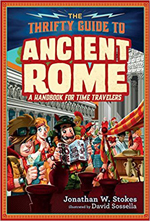 In an engaging travel guide format, this handbook for time travelers starts with an introduction on how to stay alive, what to wear, where to eat, and where to find entertainment in ancient Rome. Each section contains facts about the city’s history, geography, famous and ordinary people, and culture. In a conversational and humorous style, Stokes chronicles 1,000 years, from the founding of Rome to the time of invading armies that led to the fall of the empire. The Thrifty Guide to the American Revolution was published simultaneously, and Stokes’ third handbook, The Thrifty Guide to Ancient Greece, illustrated by Xavier Bonet, will be released in the fall.
In an engaging travel guide format, this handbook for time travelers starts with an introduction on how to stay alive, what to wear, where to eat, and where to find entertainment in ancient Rome. Each section contains facts about the city’s history, geography, famous and ordinary people, and culture. In a conversational and humorous style, Stokes chronicles 1,000 years, from the founding of Rome to the time of invading armies that led to the fall of the empire. The Thrifty Guide to the American Revolution was published simultaneously, and Stokes’ third handbook, The Thrifty Guide to Ancient Greece, illustrated by Xavier Bonet, will be released in the fall.
—SW
The Vanderbeekers of 141st Street and the Hidden Garden. Karina Yan Glaser. 2018. Houghton Mifflin.
 Spring arrives at the brownstone in Harlem, New York, and the Vanderbeeker children, Jessie, Oliver, Hyacinth, and Laney (the eldest, Isa, is at music camp) decide to create a beautiful garden in the abandoned, possibly haunted lot next to the local church. With little experience and no tools, the children must figure out how to get what they need. Then they discover another problem: The land is to be sold to a real estate developer. This story of resourcefulness, friendship, and service is the sequel to The Vanderbeekers of 141st Street (2017).
Spring arrives at the brownstone in Harlem, New York, and the Vanderbeeker children, Jessie, Oliver, Hyacinth, and Laney (the eldest, Isa, is at music camp) decide to create a beautiful garden in the abandoned, possibly haunted lot next to the local church. With little experience and no tools, the children must figure out how to get what they need. Then they discover another problem: The land is to be sold to a real estate developer. This story of resourcefulness, friendship, and service is the sequel to The Vanderbeekers of 141st Street (2017).
—SW
Early Young Adult (Ages 12–14)
Countdown: 2979 Days to the Moon. Suzanne Slade. Ill. Thomas Gonzalez. 2018. Peachtree.
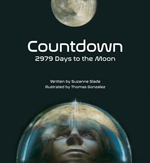 On May 25, 1961, President John F. Kennedy announced his daring dream of committing the United States to landing a man on the moon and safely returning him to earth by the end of the decade. Beautifully composed verse and dramatic paintings tell the story of Project Apollo that made that dream a reality 2979 days later, when the Eagle landed on the Moon’s surface and Apollo 11 astronauts Neil Armstrong and Buzz Aldrin became the first humans to step onto the moon on July 20, 1969. Chapters end with double-page spreads with information about the mission, including launch and splashdown dates, biographical information and a portrait of each crew member, the mission’s special patch with the names of the astronauts, and captioned photographs. Back matter includes “More About Team Apollo” and “Bringing Apollo 11 Home” sections, notes by the author and the illustrator, a bibliography, sources for quotations, and photo credits.
On May 25, 1961, President John F. Kennedy announced his daring dream of committing the United States to landing a man on the moon and safely returning him to earth by the end of the decade. Beautifully composed verse and dramatic paintings tell the story of Project Apollo that made that dream a reality 2979 days later, when the Eagle landed on the Moon’s surface and Apollo 11 astronauts Neil Armstrong and Buzz Aldrin became the first humans to step onto the moon on July 20, 1969. Chapters end with double-page spreads with information about the mission, including launch and splashdown dates, biographical information and a portrait of each crew member, the mission’s special patch with the names of the astronauts, and captioned photographs. Back matter includes “More About Team Apollo” and “Bringing Apollo 11 Home” sections, notes by the author and the illustrator, a bibliography, sources for quotations, and photo credits.
—CA
Crown of Thunder. Tochi Onyebuchi. 2018. Razorbill/Penguin.
 Taj is among the refugees fleeing Kos in this sequel to Beasts of the Night (2017). Having served Princess Karima of Kos, he is puzzled by her ruthless destruction of the people of Kos once she becomes queen, and he is morose over the loss of his dear friend, Bo. Taj joins up with a group of sin-eaters, people who can swallow the sins of others, but the Queen sends dark forces to destroy them. Traveling with friends Aliya and Arzu and longing to be a healer, a person who can transform monsters into rays of light, Taj underestimates allies he thought were adversaries. In this action-packed fantasy, Taj, Aliya, and Arzu make discoveries about themselves as they plan to overcome the Queen, but first must confront Bo, who has become her ally. You may want to read Beasts of the Night first.
Taj is among the refugees fleeing Kos in this sequel to Beasts of the Night (2017). Having served Princess Karima of Kos, he is puzzled by her ruthless destruction of the people of Kos once she becomes queen, and he is morose over the loss of his dear friend, Bo. Taj joins up with a group of sin-eaters, people who can swallow the sins of others, but the Queen sends dark forces to destroy them. Traveling with friends Aliya and Arzu and longing to be a healer, a person who can transform monsters into rays of light, Taj underestimates allies he thought were adversaries. In this action-packed fantasy, Taj, Aliya, and Arzu make discoveries about themselves as they plan to overcome the Queen, but first must confront Bo, who has become her ally. You may want to read Beasts of the Night first.
—SW
Playing Atari with Saddam Hussein: Based on a True Story. Jennifer Roy (with Ali Fadhil). 2018. Houghton Mifflin.
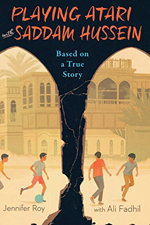 At the beginning of the Gulf War of 1991, Ali and his family, living in Basra, Iraq, have food, water, electricity, television, and video games. When all-night bombing starts, however, Ali, his dentist father, mathematics teacher mother, two brothers, and young sister are crowded into a safe room, where they sleep on the floor. In running across the rubble of bombed neighborhoods to bring home his family’s government rations, Ali is Pitfall Harry (a video game character who gets out of tight spots), but as the war intensifies and the family’s living conditions worsen, his life becomes more complex. Ali’s experience of the Gulf War is also the story of a young man’s discovery of the depth of his culture as he finds his role in it.
At the beginning of the Gulf War of 1991, Ali and his family, living in Basra, Iraq, have food, water, electricity, television, and video games. When all-night bombing starts, however, Ali, his dentist father, mathematics teacher mother, two brothers, and young sister are crowded into a safe room, where they sleep on the floor. In running across the rubble of bombed neighborhoods to bring home his family’s government rations, Ali is Pitfall Harry (a video game character who gets out of tight spots), but as the war intensifies and the family’s living conditions worsen, his life becomes more complex. Ali’s experience of the Gulf War is also the story of a young man’s discovery of the depth of his culture as he finds his role in it.
—SW
Older Young Adult (14+)
Lies You Never Told Me. Jennifer Donaldson. 2018. Razorbill/Penguin.
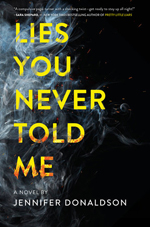 Following a breakup with his controlling girlfriend, Sasha, Gabe’s friendship with a shy, reclusive new student, Catherine, grows into a romantic relationship that must remain a secret. Meanwhile, headstrong and popular Sasha is determined to win him back. In Portland, Oregon, Elyse finds escape from a troubled home life with her opioid-addicted mother when Mr. Hunter, the drama teacher, casts her as Juliet in the school production of Romeo and Juliet. The special attention Elyse gets from him leads her down a slippery slope. Told in fast-paced alternating chapters, these two seemingly unconnected stories come together with an unexpected twist.
Following a breakup with his controlling girlfriend, Sasha, Gabe’s friendship with a shy, reclusive new student, Catherine, grows into a romantic relationship that must remain a secret. Meanwhile, headstrong and popular Sasha is determined to win him back. In Portland, Oregon, Elyse finds escape from a troubled home life with her opioid-addicted mother when Mr. Hunter, the drama teacher, casts her as Juliet in the school production of Romeo and Juliet. The special attention Elyse gets from him leads her down a slippery slope. Told in fast-paced alternating chapters, these two seemingly unconnected stories come together with an unexpected twist.
—CA
Little and Lion. Brandy Colbert. 2017. Little, Brown.
 When she arrives home to Los Angeles from her boarding school in New England, 16-year-old Suzette has a lot to deal with, including unsettling relationships within her blended family. Wanting to rebuild the strong emotional bond she once had with Lionel, who is under treatment for bipolar disorder, Suzette is conflicted about keeping his secret that he has gone off his medications. She is also dealing with identity issues, having just left her first same-sex relationship with her roommate and discovering sexual attraction to both an old friend, Emil, and a coworker, Rafaela. Suzette has a lot of growing up to do this summer.
When she arrives home to Los Angeles from her boarding school in New England, 16-year-old Suzette has a lot to deal with, including unsettling relationships within her blended family. Wanting to rebuild the strong emotional bond she once had with Lionel, who is under treatment for bipolar disorder, Suzette is conflicted about keeping his secret that he has gone off his medications. She is also dealing with identity issues, having just left her first same-sex relationship with her roommate and discovering sexual attraction to both an old friend, Emil, and a coworker, Rafaela. Suzette has a lot of growing up to do this summer.
—CA
Select Few (The Select #2). Marit Weisenberg. 2018. Charlesbridge Teen/Charlesbridge.
 After leaving a closed, cult-like community led by her father, Julia Jaynes moves into an exclusive hotel in Austin, Texas. Julia must suppress her special abilities if she is to avoid notice, and realizes she must also separate from her boyfriend, John Ford (who has been developing special abilities of his own while they have been together), to keep him safe from being kidnapped by the community. Julia has many painful decisions to make and, along the way, makes some wrong ones, all of which contributes to this satisfying sequel to Select (2017), the first book in this thrilling paranormal romance series.
After leaving a closed, cult-like community led by her father, Julia Jaynes moves into an exclusive hotel in Austin, Texas. Julia must suppress her special abilities if she is to avoid notice, and realizes she must also separate from her boyfriend, John Ford (who has been developing special abilities of his own while they have been together), to keep him safe from being kidnapped by the community. Julia has many painful decisions to make and, along the way, makes some wrong ones, all of which contributes to this satisfying sequel to Select (2017), the first book in this thrilling paranormal romance series.
—CA
What I Leave Behind. Alison McGhee. 2018. Caitlyn Dlouhy/Atheneum/Simon & Schuster.
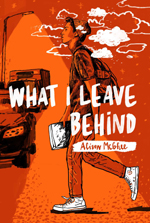 “Sometimes you got to walk the day out of you,” says the narrator, 16-year-old Will, who began walking the streets of his Los Angeles neighbor to deal with loss and grief. According to Will, a walker’s feet can figure out the right route to take, the route that does not go past places that need to be avoided. For Will, these include the river bridge over Fourth Street, the site of his father’s suicide; the house of his friend Playa, who was raped at a party; and the Chinese blessing store he used to visit with his father. Written in 100 chapters with 100 words per chapter, the author shows how connecting with people through small acts of kindness helps Will walk off his troubles.
“Sometimes you got to walk the day out of you,” says the narrator, 16-year-old Will, who began walking the streets of his Los Angeles neighbor to deal with loss and grief. According to Will, a walker’s feet can figure out the right route to take, the route that does not go past places that need to be avoided. For Will, these include the river bridge over Fourth Street, the site of his father’s suicide; the house of his friend Playa, who was raped at a party; and the Chinese blessing store he used to visit with his father. Written in 100 chapters with 100 words per chapter, the author shows how connecting with people through small acts of kindness helps Will walk off his troubles.
—CA
Sandip LeeAnne Wilson serves as professor in the School of Education and the English Department of Husson University, Bangor, Maine. Carolyn Angus is former director of the George G. Stone Center for Children's Books, Claremont Graduate University, in Claremont, California.
These reviews are submitted by members of the International Literacy Association's Children's Literature and Reading Special Interest Group (CL/R SIG) and are published weekly on Literacy Daily.